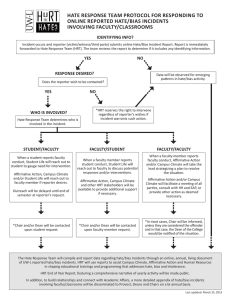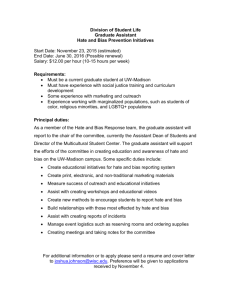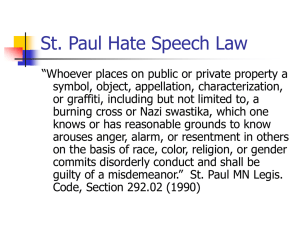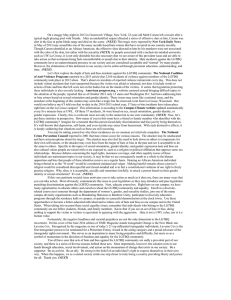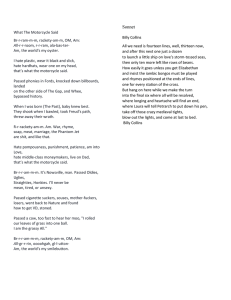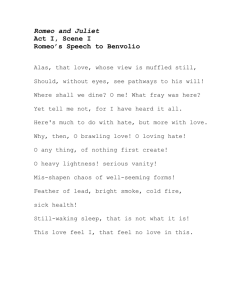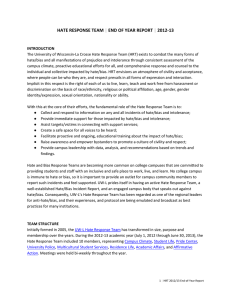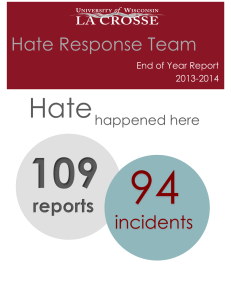HATE RESPONSE TEAM PROTOCOL FOR RESPONDING TO ONLINE REPORTED HATE/BIAS INCIDENTS
advertisement
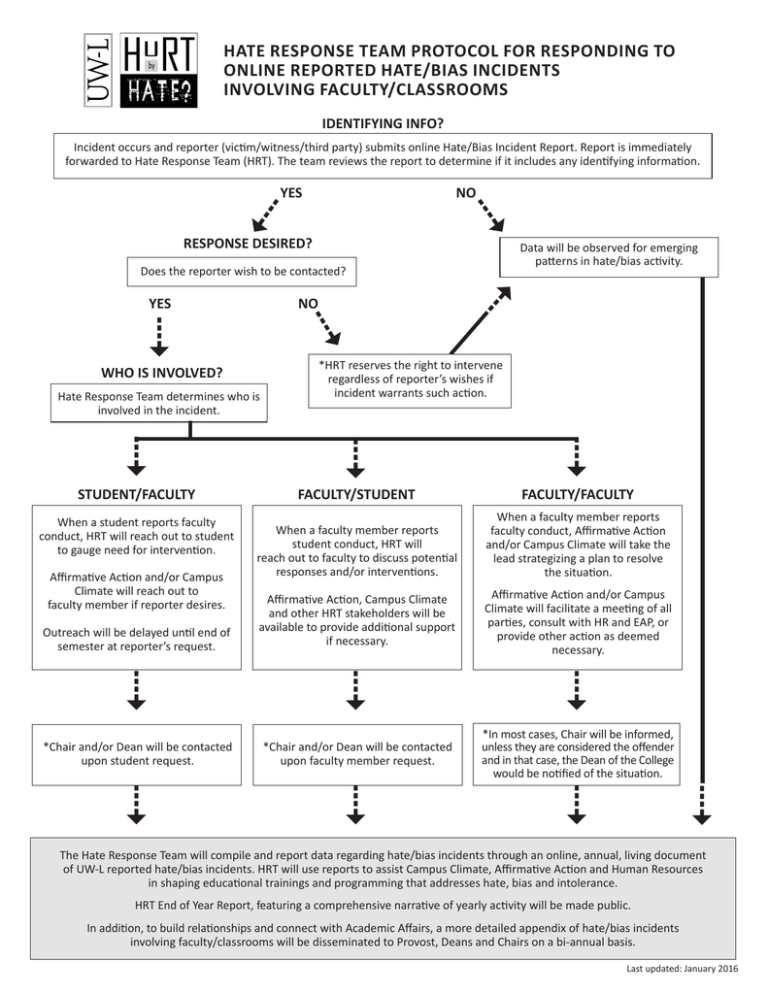
HATE RESPONSE TEAM PROTOCOL FOR RESPONDING TO ONLINE REPORTED HATE/BIAS INCIDENTS INVOLVING FACULTY/CLASSROOMS IDENTIFYING INFO? Incident occurs and reporter (victim/witness/third party) submits online Hate/Bias Incident Report. Report is immediately forwarded to Hate Response Team (HRT). The team reviews the report to determine if it includes any identifying information. 6 YES NO RESPONSE DESIRED? 6 Does the reporter wish to be contacted? NO 6 WHO IS INVOLVED? Hate Response Team determines who is involved in the incident. 6 STUDENT/FACULTY When a student reports faculty conduct, HRT will reach out to student to gauge need for intervention. Affirmative Action and/or Campus Climate will reach out to faculty member if reporter desires. 6 6 YES Data will be observed for emerging patterns in hate/bias activity. *HRT reserves the right to intervene regardless of reporter’s wishes if incident warrants such action. 6 6 FACULTY/STUDENT FACULTY/FACULTY When a faculty member reports student conduct, HRT will reach out to faculty to discuss potential responses and/or interventions. When a faculty member reports faculty conduct, Affirmative Action and/or Campus Climate will take the lead strategizing a plan to resolve the situation. Outreach will be delayed until end of semester at reporter’s request. Affirmative Action, Campus Climate and other HRT stakeholders will be available to provide additional support if necessary. Affirmative Action and/or Campus Climate will facilitate a meeting of all parties, consult with HR and EAP, or provide other action as deemed necessary. 6 6 6 *Chair and/or Dean will be contacted upon student request. *Chair and/or Dean will be contacted upon faculty member request. 6 6 *In most cases, Chair will be informed, unless they are considered the offender and in that case, the Dean of the College would be notified of the situation. 6 6 The Hate Response Team will compile and report data regarding hate/bias incidents through an online, annual, living document of UW-L reported hate/bias incidents. HRT will use reports to assist Campus Climate, Affirmative Action and Human Resources in shaping educational trainings and programming that addresses hate, bias and intolerance. HRT End of Year Report, featuring a comprehensive narrative of yearly activity will be made public. In addition, to build relationships and connect with Academic Affairs, a more detailed appendix of hate/bias incidents involving faculty/classrooms will be disseminated to Provost, Deans and Chairs on a bi-annual basis. Last updated: January 2016 HATE RESPONSE TEAM GUIDING PRINCIPLES FOR RESPONDING TO ONLINE REPORTED HATE/BIAS INCIDENTS INVOLVING FACULTY/CLASSROOMS Key Points: • Every situation is unique • Ability to resolve these incidents through collaborative dialogue reduces the need for a formal grievance being filed • Respect for academic freedom - with expectation that provocative content/teaching methods will be used in a fashion that does not create a discriminatory environment • Respect for due process rights of faculty -This is a collaborative dialogue-oriented process, about building awareness, assuming good intentions, and shared desire to create better & more inclusive learning environments, not about punishing, penalizing, or stigmatizing anyone - If information that identifies a particular faculty/IAS member is being provided to a chair or dean, the faculty/IAS member will be notified in advance except in rare cases where there is a safety, legal or confidentiality concern • Victim/target has 3 immediate needs at the forefront: the need to feel safe, the need to be heard and the need to know what happens next *Individual situations in which we will inform (and may request involvement from) Deans or Chairs: • Student(s) requests action, sufficient details are known, faculty member unwilling to engage in dialogue • Report meets elevated standard of harassment, hostile environment, etc. under applicable laws triggering legal obligation to respond • Repeated incidents involving the same faculty/IAS member Bi-annual report regarding faculty/classroom incidents: • Specific examples; identifying information (student, faculty, department, etc.) removed • Disseminated to Provost, Deans and Chairs at the close of each semester • Will include information on resolution (achieved, attempted, attempted but not achieved, not attempted) • Intended purpose of report is to provide opportunity for deans and chairs to dialogue with faculty and IAS, citing examples of conduct that is not acceptable and scenarios in which more incisive language would be desired
